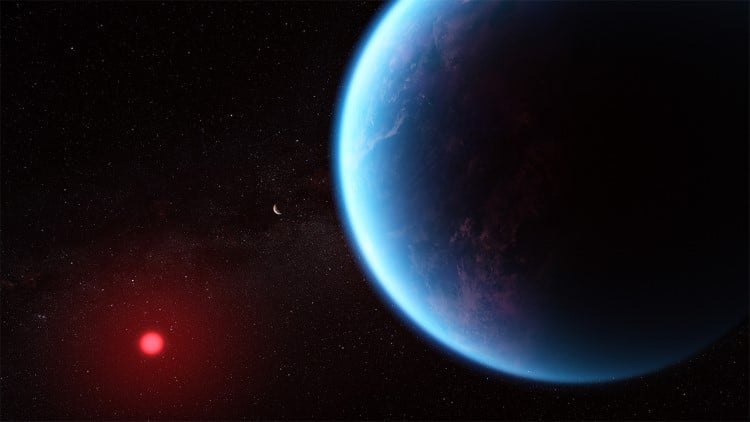
Illustration showing what exoplanet K2-18 b could look like based on scientific data. (Photo: Illustration NASA, ESA, CSA, Joseph Olmsted (STScI) Science Nikku Madhusudhan (IoA))
NASA’s James Webb Space Telescope has made yet another discovery, and this may be one of its most exciting ones yet. When investigating an exoplanet 8.6 times the size of Earth, Webb found that it may be a Hycean world. This means that it has a hydrogen-rich atmosphere and a single ocean covering its entire surface. And, what’s more, there was even a possible discovery of a molecule that, on Earth, is only produced by living organisms.
Exoplanet K2-18 b was discovered in 2015 by the Kepler Space Telescope, but Webb’s observations are giving us a whole new set of information. By finding carbon-bearing molecules, including methane and carbon dioxide, Webb has added further evidence to the hypothesis that K2-18 b could be a Hycean world. This is important because many astronomers feel that this type of exoplanet could be hospitable to life.
“Our findings underscore the importance of considering diverse habitable environments in the search for life elsewhere,” explained Nikku Madhusudhan, an astronomer at the University of Cambridge and lead author of the paper announcing these results. “Traditionally, the search for life on exoplanets has focused primarily on smaller rocky planets, but the larger Hycean worlds are significantly more conducive to atmospheric observations.”
Webb also found possible traces of dimethyl sulfide (DMS). On Earth, this molecule is produced by life. Most of the DMS in the Earth’s atmosphere is released by phytoplankton. While the presence of DMS in the exoplanet could be a good indicator that it is habitable, researchers still want to exercise caution.
The telescope will need to run further validations to see if its initial observations were correct. “Upcoming Webb observations should be able to confirm if DMS is indeed present in the atmosphere of K2-18 b at significant levels,” Madhusudhan explains.
Though the exoplanet, which is located in the Leo constellation, is in the habitable zone, there’s no guarantee it can support life. Even if it is a Hycean world, the ocean could be too hot or too liquid for life to thrive. That’s all part of the exciting mystery that astronomers are working out right now and is what makes Webb’s observations so thrilling.
Webb Space Telescope: Website | Facebook | Instagram | YouTube
Related Articles:
Water Is Discovered in the Atmosphere of a Potentially Habitable Exoplanet
James Webb Space Telescope Just Proved it Can Find Signs of Life on Other Planets
JWST Captures Square-Shaped Ripple Rings Around a Star, Perplexing Astronomers
Listen to the Beautiful Sounds of NASA Discovering Over 5,000 Exoplanets Since 1992
